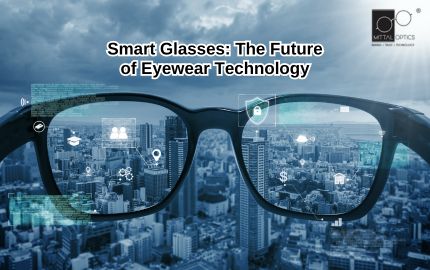The world of eyeglasses is on the verge of a major change. Smart glasses, which were previously only found in science fiction stories, are now becoming more common. These advanced spectacles claim to mix up the online and physical universes in an unprecedented manner – literally speaking. Now, let us discuss the possible impact of smart glasses on our regular life as we prepare to enter this thrilling age.
The Evolution of Eyewear
To understand the importance of smart glasses, we need to think about how eyewear has changed. Eyeglasses have been used for a long time, starting with magnifying glasses in the 1200s and then bifocals made by Benjamin Franklin around 1700. The main idea behind all types of eyewear is improving human vision. In the 1900s, contact lenses and laser eye surgery were introduced as other choices to regular glasses. Now, in the 21st century, we are experiencing the next progression: glasses that do more than just improve our eyesight but also enhance how we perceive things around us.
What Are Smart Glasses?
Smart glasses, as the name implies, are computer devices that can be worn on the face. They come with a small display screen and provide information alongside what you see in front of your eyes or they add to it directly. Usually, smart glasses have features such as a tiny-sized display, camera for video recording or taking pictures, microphone and speakers or audio transmitters. Some models also incorporate sensors like accelerometers and gyroscopes to track head movements.
The possible uses of smart glasses are wide-ranging. These are some important functions and situations they can be used in:
- Displays with Augmented Reality: The capacity to project digital information straight into the user’s vision area
- Navigation: Providing turn-by-turn directions overlaid on the real world
- Information Access: Displaying relevant information about objects or locations in view
- Communication That Doesn’t Require the Use of Hands: It lets the user make a phone call or send a message without needing to touch anything.
- Photography and Video Recording: Capturing first-person perspective images and videos
- Health Monitoring: Tracking vital signs and providing real-time health data
- Language Translation: Offering real-time translation of foreign languages
- Professional Uses: Supports areas such as medicine, engineering and manufacturing by showing specific information.
Current State of Smart Glasses Technology
The idea of smart glasses has been present for a while, with visible efforts such as Google Glass in the year 2013. However, it is only at this time that the technology starts to mature. Big companies like Apple, Facebook (now Meta), and Google are putting significant resources into AR (augmented reality) technology; they view smart glasses as a possible heir to smartphones.
Smart glasses that are presently available in the market have dedicated functionalities. There are models for sportspeople, giving them performance statistics in real-time; others made specifically for business workers to gain access to information and communication tools without using their hands. Yet, this technology is still at its initial phase and there are numerous obstacles that must be tackled before smart glasses can become as common as smartphones.
Challenges and Limitations
Smart glasses show promise but still have problems. Battery life is a big hurdle because they must be light and strong enough to operate complicated apps. Display technology also needs improvement for making screens that are bright, clear and not blocking normal vision.
Worries about privacy are also a big factor. The concept of individuals putting on cameras over their eyes brings up concerns regarding approval and observation. To win trust and approval from the public, makers must handle these matters.
The Future of Smart Glasses
In future, the idea of smart glasses has huge potential to become a reality. Picture yourself strolling along a city road and historical details about buildings appearing in your vision. Or consider thinking of smart glasses for education – students can view 3D models that represent complex ideas right before their own eyes.
In the field of healthcare, smart glasses might change the way surgeons do operations. Glasses with built-in technology could show patient information and give 3D views of body parts during a surgery. For those who have difficulty seeing, these devices may provide significant help by explaining what is happening in their surroundings.
Also, the workplace might change. Technicians could use repair manuals without hands, and architects could see their designs in real-life situations. The potential is almost infinite.
In a future with 5G networks, smart glasses could get their strength from cloud computing. They may not require large on-board hardware to do complex jobs.
Societal Implications
Smart glasses being used commonly may bring significant changes to society. Similar to how smartphones altered communication and information access, smart glasses might impact our way of perceiving and interacting with the world.
There is worry about distraction and too much information. If we can always see digital info, will it make us disconnected from the physical world? What impact might this have on how people interact when they know that everything could be recorded or looked up?
Conclusive Words
Smart glasses show the coming together of several advanced technologies: increased reality, artificial intelligence, small-sized computing and innovative display tech. Though it’s just beginning now, the possibilities for this technology to change our lives are huge.
This is for sure, the future of eyewear is smart. As these things change and become better, they could grow to be as essential as our cell phones are now. The way we view the world will soon alter and smart glasses shall act as our tool to view this fresh augmented reality.

